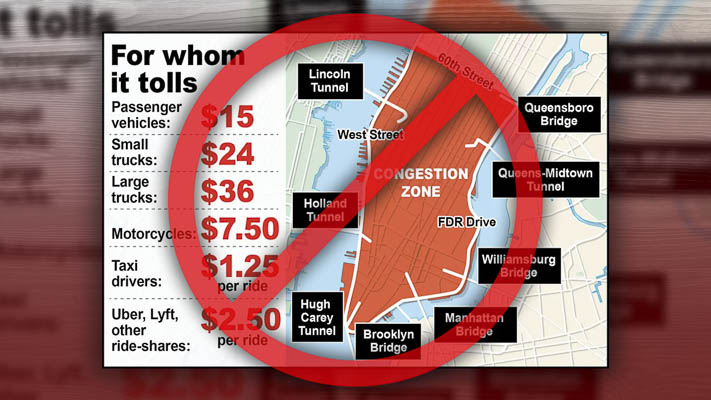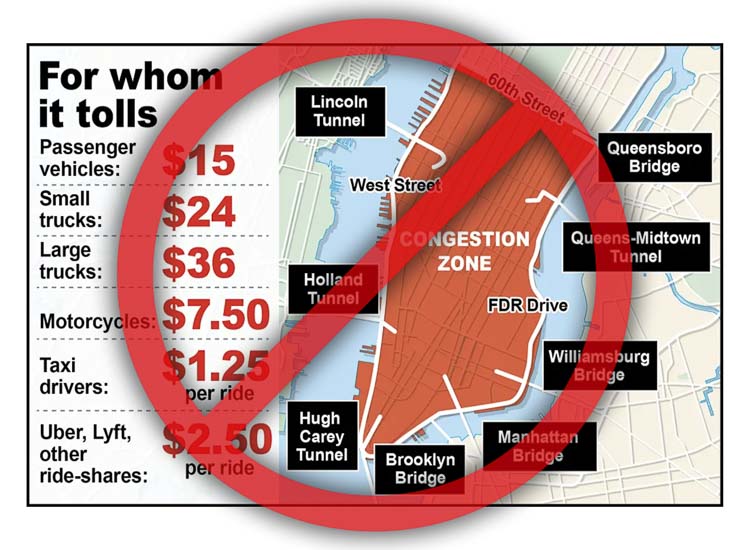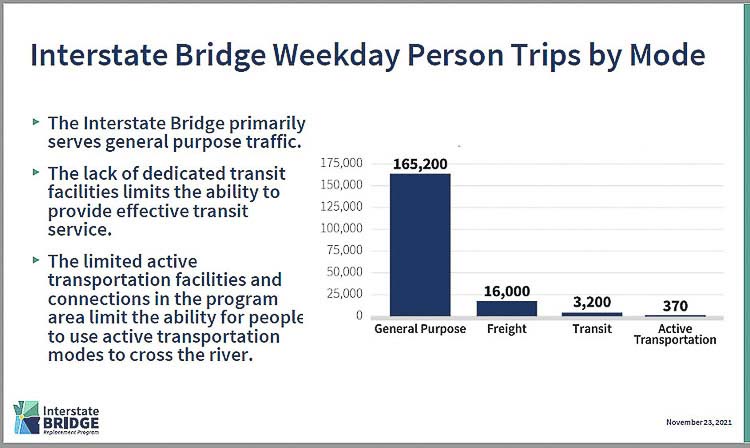
Governors in Oregon and New York stop unpopular congestion tolling
John Ley
for Clark County Today
Tolling cars and trucks to pay for mass transit was killed in New York City this week by New York Governor Kathy Hochul. The congestion pricing scheme was going to charge car drivers $15 each time they entered the downtown Manhattan “zone.” Trucks would have paid between $24 and $36. Hochul is worried that it’s “not the right time” as New Yorkers face a cost-of-living crisis.
The tolling was to begin on June 30. The extremely controversial plan hoped to collect $1 billion a year for the Metropolitan Transportation Authority, which runs the NYC subway and bus system. Pushback from locals included noting roughly $5 billion the MTA has wasted since 2017.
The rejection of a congestion pricing scheme that charges higher rates when most people are on the roads, and lower rates at night and on weekends, also happened in Oregon. Governor Tina Kotek recently “indefinitely paused” Oregon’s per mile congestion pricing tolling scheme. It was to begin on I-205 and later expanded to all Portland area freeways and highways.

This is of vital interest to Southwest Washington residents because congestion pricing tolls are part of the Interstate Bridge Replacement Program (IBRP). Administrator Greg Johnson wants to borrow between $1.2 and $1.5 billion from Wall Street to fund the current $6 billion finance plan. The money would be paid back with variable rate tolls initially estimated to be $2.15 to $3.55 beginning in 2026 with pre-construction tolls.
Currently, four members of the Washington and Oregon Transportation Commissions are meeting monthly, discussing a variety of options for the IBRP tolls. Clark County’s Roy Jennings is a member of that sub committee.
Critical to the discussions will be “how much” money needs to be raised via tolling. Johnson told bistate legislators in December that the current $5-7.5 billion price would be going up. Seven months later, details on the new cost have not been released.
But with Oregon facing approximately a $3 billion transportation project funding shortfall, it’s likely the increased cost will need to be funded with even higher toll rates. Kotek is asking the 2025 legislature to consider a major transportation package to pay for that shortfall. She has not excluded tolling.
Recently, Johnson told the IBR’s Equity Advisory Committee that the current two I-5 bridges have 89 percent of their structure dedicated to cars and freight haulers. His team is designing the replacement structure to decrease that to just 55 percent. Nearly half the planned structure will be for transit, pedestrians, and bicyclists. “This is not an afterthought, but a serious attempt to give people options of how they travel through this corridor,” he said.
At the current $7.5 billion price tag, that would indicate $4.125 billion allocated to vehicles and $3.375 billion is transit and active transportation. Community members have been told the light rail component is nearly $2 billion, therefore $1.4 billion would be allocated for active transportation. That’s right in the middle of the $1.2 -$1.5 billion Johnson says needs to be raised via tolling. No one has mentioned tolling or fees for bicyclists and pedestrians, therefore taxpayers will be picking up the tab.
It’s not a stretch to believe tolls, paid by cars and freight haulers, will be footing a sizable portion of the transit and active transportation portion of the bridge. Federal law limits the Federal Transit Administration (FTA) to paying for no more than half the capital costs of a new transit project. Therefore the FTA may contribute at most $1 billion for the $2 billion light rail extension cost.

The current IBR finance plan only raises $6 billion. IBR officials hope to get $2.5 billion from the federal government, $1 billion each from Oregon and Washington, and up to $1.5 billion from tolling. That’s $1.5 billion short of the top end of the current $7.5 billion price tag, and an unknown amount short of a much higher price. Portland economist Joe Cortright has estimated the top end of the cost could be $9 billion.
Thus far, there have been no discussions about trimming costs of the project. With a “new normal” in people working from home and almost nobody riding transit over the Columbia River, an easy way to trim $2 billion would be to switch the transit component from the 3-mile MAX light rail extension to C-TRAN express buses. The number of bus routes to Portland have been cut in half due to lower transit ridership.
Clark County Today editor Ken Vance opined recently that the Evergreen Transit Center and the creation of real estate over I-5 could be eliminated. The 75-80 foot high waterfront transit station could also be eliminated. “By reducing the price tag of the I-5 Bridge replacement project, the burden on taxpayers would be reduced and the need for tolls could be eliminated,” he said.
People are tired of paying more and getting less for their transportation taxes. Tolling is an extremely inefficient means of raising money for transportation. Late last year it was revealed that ODOT’s plan for I-205 tolls had an 83-86 percent cost of collection. “The first six trips, all your tolls pay for overhead,” West Linn Mayor Rory Bialostosky said in an interview. “Only the seventh trip pays for borrowed money,” to fund the Abernethy bridge.
A recent poll indicated 76 percent of Portland area residents opposed tolling. The highest opposition was in Clackamas County, at 91 percent. Washington County opposition was 76 percent and Multnomah County 69 percent. Clark County residents were not included in the poll.
The Washington State Transportation Commission recently raised maximum Seattle area tolls on I-405 by 50 percent to $15 and 66 percent on SR-167. The state legislature has bailed out the Tacoma Narrows Bridge tolling program five times due to public pressure.
The Clark County Council has adopted a position against tolling for the IBR. They also are against light rail and want a focus on actually reducing traffic congestion and new transportation corridors, including third and fourth bridges. Clark County residents have rejected light rail multiple times at the ballot box.

Also read:
- Opinion: Hiding the growing cost of the Interstate Bridge replacementJoe Cortright of the City Observatory addresses the rising cost of the Interstate 5 Bridge replacement project.
- 90 minutes of delay on Southbound I-5 in Southwest Washington on Friday afternoon, July 26Travelers using southbound Interstate 5 through Woodland should expect up to 90 minutes of delay during Friday afternoon and evening and should delay travel or prepare for additional travel time.
- Nighttime paving work on I-5 and SR 14 in Clark County July 28-Aug. 9Nighttime travelers in Clark County should expect delays for maintenance and paving work beginning Sunday, July 28 until the morning of Friday, Aug. 9.
- Northeast 182nd Avenue/Northeast Ward Road to be closed on Aug. 1Northeast 182nd Avenue and Northeast 172nd Avenue in Clark County will have single-day closures on August 1 and August 5 for road preservation, with detours in place.
- Interstate Bridge Replacement program awarded $1.499 billion FHWA Bridge Investment Program grantInterstate Bridge Replacement program officials have shared that the program received $1.499 billion through the Federal Highway Administration’s Bridge Investment Program.









